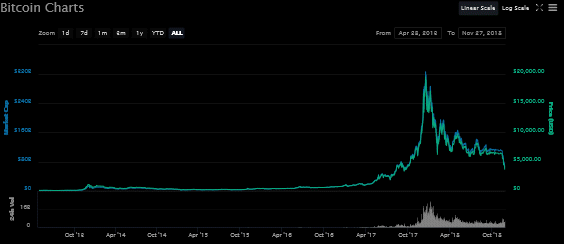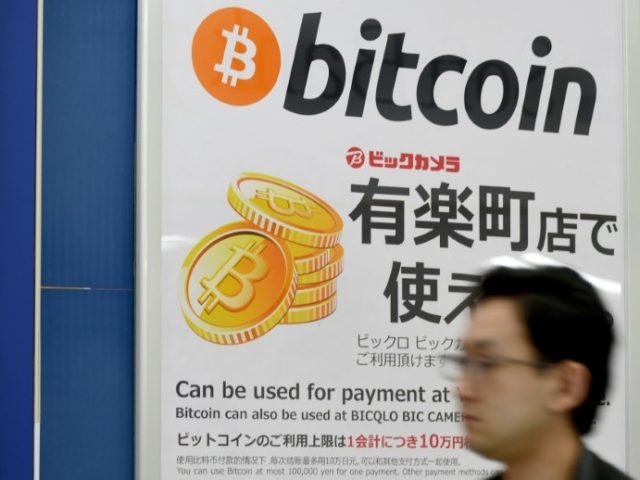This morning’s key headlines from GenerationalDynamics.com
- Bitcoin super-bubble implodes and crashes below $4,000
- China’s ‘Belt and Road Initiative (BRI) Bubble’ may be in trouble
Bitcoin super-bubble implodes and crashes below $4,000

Bitcoin price at $3,750 on 27-Nov-2018 (CoinMarketCap.com)
The price of a Bitcoin fell to $3,700 on Tuesday, down from a peak close to $20,000 in December of last year.
A little over a year ago, in response to people asking my advice about investing in Bitcoin, I wrote about Bitcoin just after its price surged past $5,000. In the article I wrote, “Investing in Bitcoin is the road to disaster. I literally cannot think of a worse investment today than Bitcoin, or the various copycat newcomers, such as Ethereum. Bitcoin is almost literally a Ponzi scheme backed by nothing but air.”
So Dear Reader, I hope you took my advice because, if you did not, then you have lost money. Many people lost a great deal of money investing as the price increased parabolically all the way up to $20,000, and those people have lost a LOT of money.
What are analysts saying today? Some are saying that Bitcoin has bottomed, and now will go up. One says that Bitcoin will fall further to about $3,000, and then will go up. Another says that it will remain about where it is now for several months, and then will go up. These are the same people who have always said it would go up, even while it was crashing.
This reminds me of the housing bubble in the mid-2000s decade. I was writing as early as 2004 that there was a housing bubble, as did a few others. It was perfectly obvious. But the “experts” on CNBC and in the Wall Street Journal kept saying that “Housing prices can’t go down – people have to live somewhere,” and “Banks won’t foreclose – it’s not in their interest to do so” and “These housing construction firms know what they’re doing, and they wouldn’t be building houses if it were just a bubble.”
It was not until around 2009 or 2010 that these “experts” even admitted that there had been a housing bubble, and then they pretended that they had known it all along. It was the same with the Iraq war, which everyone was in favor of in 2003, but then years later pretended that they had been against it all along.
So now we have experts making predictions about the future price of Bitcoin. How is any prediction of any kind even possible?
If you want to predict the future price of stock shares, you can look at a company’s earnings history. If you want to predict future corporate bond prices, you can look at a company’s assets. If you want to predict the future price of corn, you can look at yield estimates that you get from the Department of Agriculture.
But for Bitcoin, there is nothing, absolutely nothing on which to base any prediction.
Bloomberg and CNBC and NewsBTC and MarketWatch and Coin Market Cap
Related Articles
- Bitcoin super-bubble surges through $5,000 and blasts even higher (16-Oct-2017)
- Fed Reserve Chairman Janet Yellen says ‘no financial crisis in our lifetimes’ (02-Jul-2017)
- Updating the ‘real value’ of the stock market (03-Aug-2010)
- A primer on financial engineering and structured finance (23-Jan-2008)
China’s ‘Belt and Road Initiative (BRI) Bubble’ may be in trouble

China – prices for iron and steel has crashed in the last month (FT)
The above graph shows that the prices of iron and steel in China have crashed in the last month, with the right part of the graph looking very similar to the Bitcoin graph above. Maybe the two are linked in some way, or maybe it is just a coincidence that they are both crashing at the same time, but either way the fall in iron and steel prices in China is the latest sign that the economy has been weakening for about six months.
It is my personal opinion that China’s Belt and Road Initiative (BRI) is in a massive bubble of its own.
The BRI is a breathtaking project spending as much as $1.3 trillion on railways, roads, seaports, and power grids, now extending into a least 76 countries, mostly developing nations in Asia, Africa, and Latin America, together with a handful of countries on the eastern edge of Europe.
My feeling, based on many, many things that I have read in the last year, is that China’s BRI is a humongous financial disaster in the making. The other side of “debt trap diplomacy” is that all these debt traps will be sprung at roughly the same time, as each debt trap default creates a level of panic that triggers defaults in other debt traps.
What most people do not understand is any bank or company can “create” money by issuing debt. People think that only the federal government can create money, but the money created by issuing debt is 100 percent identical to the money created by the federal government. And in a debt bubble, money created by issuing debt vanishes when the bubble bursts.
There are a few things about the BRI that I find troubling and indicative of a financial crisis.
First, the utter secrecy of the terms of the BRI deals, in particular the amount of debt being created, and the terms of repayment. I do not see any reason why that information cannot be made public for each country, even if other deals still have to be kept secret. By keeping the debt secret, China evokes a great deal of suspicion of bribery, corruption, and debt-trap diplomacy.
Second, as we recently reported, the terms of China’s loan to the Maldives are becoming public thanks to a surprise election victory and change of administrations. The new president, Ibrahim Mohamed Solih, asked China’s ambassador Zhang Lizhong how much the Maldives owed to China and he was handed an invoice for the shocking amount of $3.2 billion, many times more than Maldives could afford. This figure was so embarrassing to China that later denied that Zhang ever gave that figure. The whole situation raises suspicion of a great deal of corruption. ( “24-Nov-18 World View — Maldives can’t determine how much money it owes to China”)
So you have the huge amounts of money sloshing around 76 countries, with no public information about the terms. In this top secret environment, there must be many situations involving bribery and kickbacks, as well as country leaders lining the pockets of their family and cronies.
The third issue is what is happening in Pakistan. Pakistan is about to go into bankruptcy, but its “all-weather friend” China very surprisingly has refused to come to Pakistan’s aid. Is this because China’s slowing economy requires keeping expenses in check? China has asked Pakistan to go to the IMF, but the IMF is going to demand full details of all the Pakistan-China contracts and also require Pakistan to stop funding terrorists.
So this is what I call the “BRI Bubble.” China is funding projects in 76 countries, and most of those countries are ever going to be able to pay that money back. A crisis could occur at any time.
This is a bubble that is going to burst with catastrophic results, especially in Asia.
We keep speculating about what will trigger the next world war – South China Sea, North Korea, Mideast, Kashmir, etc. But another possibility has always been a global financial crisis triggering the world war. The Bitcoin crash may have cascading effects leading to a broader crisis but, if not, it might be the BRI bubble. Bloomberg and Sputnik News (Moscow) and Financial Times and Global Times (Beijing)
Related Articles
- Pakistan fails to get agreement from IMF for a bailout (27-Nov-2018)
- Maldives can’t determine how much money it owes to China (24-Nov-2018)
- Myanmar signs ‘debt trap’ agreement with China in response to Rohingya genocide censure (21-Sep-2018)
- Pakistan celebrates its 70th birthday, wondering what Pakistan is (15-Aug-2017)
KEYS: Generational Dynamics, Bitcoin, China, Belt and Road Initiative, BRI, Maldives, Pakistan, International Monetary Fund, IMF, BRI Bubble
Permanent web link to this article
Receive daily World View columns by e-mail

COMMENTS
Please let us know if you're having issues with commenting.